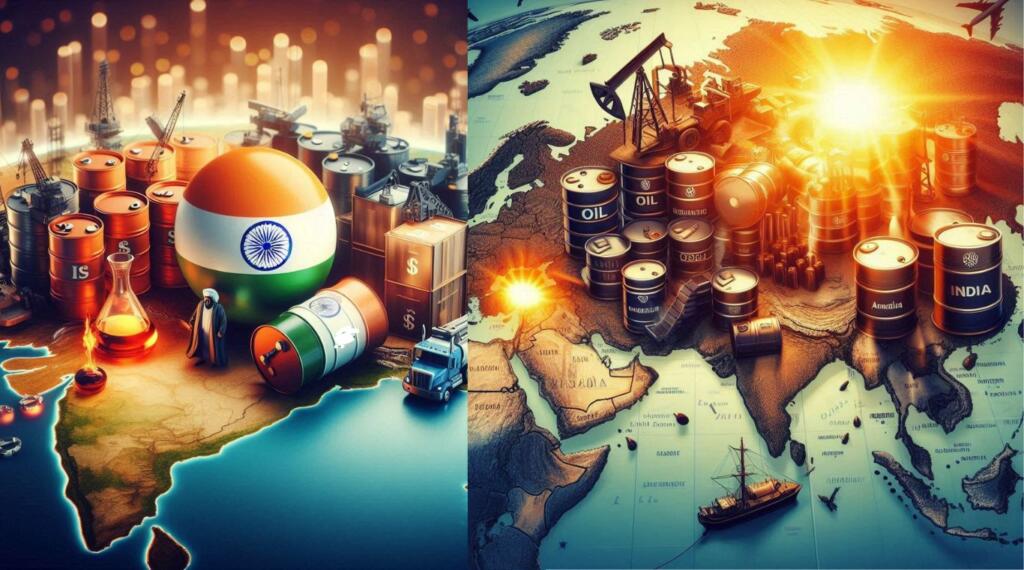From India’s point of view, Iran seriously entering and expanding the Israel-Hezbollah conflict will immediately impact its energy security. However, the silver lining is that India has been working on several options in the meantime.
The country is dependent on imports for its energy. It is one of the largest importers of oil and liquefied natural gas in the world.
A blowing-up conflict will lead to fluctuation of prices creating supply chain issues. Since October 2 oil prices have surged by over three percent because of West Asia tensions. Brent futures hit close to $76 a barrel from around $71.
The impact on India of rising prices will be such that, according to an India Today report, “for every $10 increase in oil prices, India’s inflation rate surges by nearly 0.3 percent”.
The current account deficit also “takes a worrying tone and expands by $12.5 billion or roughly 43 basis points of GDP”, as per estimates cited by multiple reports, it says.
Till July, around 42 percent of India’s import needs were met by Russia. That slipped to 36 percent in August. As a result, the share of imports from the Middle East spiked to 44.6 percent from 40.3 percent.
Iraq, Saudi Arabia, the UAE, and Kuwait are main Middle Eastern suppliers of oil to India. India also gets half of its LNG from Qatar.
The impact of a war will affect the supply chains – the biggest problem. A war in the region will affect major shipping routes in the Red Sea and through the Strait of Hormuz.
India will feel the pinch greatly by the blocking of the Strait of Hormuz through which it gets its LNG from Qatar and oil from Iraq and Saudi Arabia.
Hormuz, situated between Oman and Iran, links the Persian Gulf with the Gulf of Oman and the Arabian Sea. It is a key global chokepoint because the narrow strait handles massive volumes of oil passing through it.
The oil-producing nations in the Gulf send their product to the world’s refineries through Hormuz. A significant portion of India’s imports pass through this strait—nearly two-thirds of oil and close to half the LNG India imports.
The Economic Times reported on the impact of the blockade: “According to a Morgan Stanley report, a $10 per barrel increase could impact consumer prices by 0.2 to 1.4 percentage points across Asian economies. India is in the middle, with the Consumer Price Index (CPI) rising up to 0.5 percentage points for each $10 per barrel increase in oil prices.”
ICRA, an affiliate of Moody’s, projected in the first week of October that “India’s net oil import bill could widen to $101-104 billion in current fiscal from $96.1 billion in 2023-24 and any escalation in the Iran-Israel conflict could impart an upward pressure on the value of imports”.
This means that a $10/barrel hike in crude price this financial year can jack up net oil imports by $12-13 billion during the year, thus widening the current account deficit by 0.3 percent of India’s GDP.
The widening conflict could also jeopardise the progress of the India-Middle East-Europe Economic Corridor (IMEC), announced last year during the G20 meeting in New Delhi. The idea is an Eastern Corridor connecting India to the Gulf region and a Northern Corridor connecting the Gulf region to Europe.
So, does India have other options?
Significantly, India is an old hand at handling fluctuations in crude prices owing to geopolitical disturbances in the last several decades.
Most of its importers are in the world’s most vulnerable regions. Yet, India has managed to overcome all crises to import the crude it needs, notwithstanding hiked prices.
It is possible that a conflict situation may make India turn to Russia to buy more oil. Despite the American sanctions on Russia, India may not face any trouble getting more oil. But the oil cannot travel to India if the Red Sea route is closed. It will have to take the longer, more expensive, way via the Cape of Good Hope.
Among the possible future options India would already be considering, according to oilprices.com, is that India may “accelerate the development of its domestic oil and gas resources.
It says in its latest report: “Four largely unexplored sedimentary basins in India could hold up to 22 billion barrels of oil, S&P Global Commodity Insights has reported. In effect, lesser-known Category-II and III basins namely Mahanadi, Andaman Sea, Bengal, and Kerala-Konkan contain more oil than the Permian Basin which has already produced 14 billion of its 34 billion barrels of recoverable oil reserves.”
India also has the opportunity to promote deep-sea oil exploration. Oil India and ONGC have acreages in the Andaman waters and have finalised several projects. The country needs foreign expertise in ultra-deepwater exploration to go ahead.
Petroleum Minister Hardeep Singh Puri is on record saying that though only 10 percent of India’s 3.36 million s km wide sedimentary basin is under exploration, the figure will jump to 16 percent later this year following the awarding of blocks under the Open Acreage Licensing Policy (OALP) rounds.
Anticipating future troubles, India embarked on a multiple strategy in 2016 to secure its long-term oil security needs comprising diversifying supply sources, investing in oil fields, and using financial interests.
The Indian Council on Global Relations came up with a paper saying India should be looking at Canada, apart from Russia, as an important importer because of future instabilities that are bound to affect the Middle East.
It must also “become more proactive in acquiring oil fields in other countries” as “ownership of oil fields will allow India to accrue some of the value of rising oil prices; it will also offer a measure of protection against rising oil prices”. ONGC has been doing the acquiring in the last decade.
Last but not least, the Council paper suggests India turning “to the financial markets to protect itself against price spikes”.
